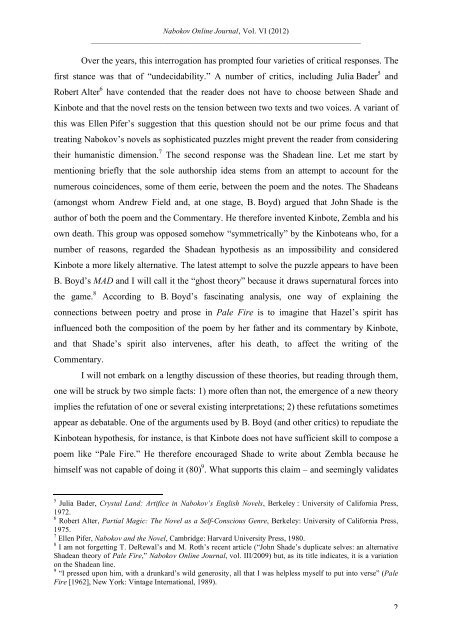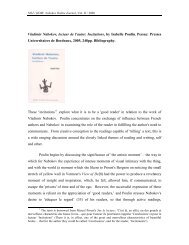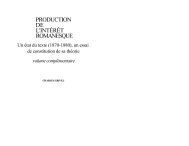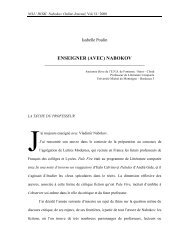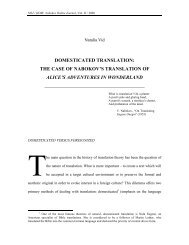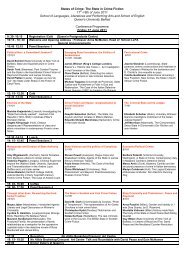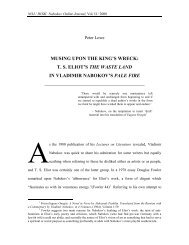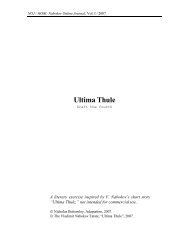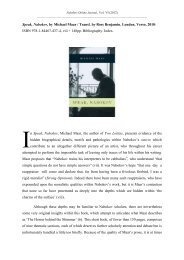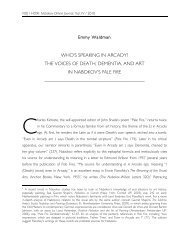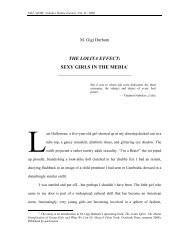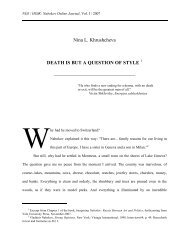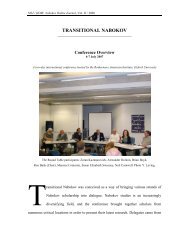through the looking-glass – pale fire as anamorphosis
through the looking-glass – pale fire as anamorphosis
through the looking-glass – pale fire as anamorphosis
You also want an ePaper? Increase the reach of your titles
YUMPU automatically turns print PDFs into web optimized ePapers that Google loves.
Nabokov Online Journal, Vol. VI (2012)<br />
_______________________________________________________________________<br />
Over <strong>the</strong> years, this interrogation h<strong>as</strong> prompted four varieties of critical responses. The<br />
first stance w<strong>as</strong> that of “undecidability.” A number of critics, including Julia Bader 5 and<br />
Robert Alter 6 have contended that <strong>the</strong> reader does not have to choose between Shade and<br />
Kinbote and that <strong>the</strong> novel rests on <strong>the</strong> tension between two texts and two voices. A variant of<br />
this w<strong>as</strong> Ellen Pifer’s suggestion that this question should not be our prime focus and that<br />
treating Nabokov’s novels <strong>as</strong> sophisticated puzzles might prevent <strong>the</strong> reader from considering<br />
<strong>the</strong>ir humanistic dimension. 7 The second response w<strong>as</strong> <strong>the</strong> Shadean line. Let me start by<br />
mentioning briefly that <strong>the</strong> sole authorship idea stems from an attempt to account for <strong>the</strong><br />
numerous coincidences, some of <strong>the</strong>m eerie, between <strong>the</strong> poem and <strong>the</strong> notes. The Shadeans<br />
(amongst whom Andrew Field and, at one stage, B. Boyd) argued that John Shade is <strong>the</strong><br />
author of both <strong>the</strong> poem and <strong>the</strong> Commentary. He <strong>the</strong>refore invented Kinbote, Zembla and his<br />
own death. This group w<strong>as</strong> opposed somehow “symmetrically” by <strong>the</strong> Kinboteans who, for a<br />
number of re<strong>as</strong>ons, regarded <strong>the</strong> Shadean hypo<strong>the</strong>sis <strong>as</strong> an impossibility and considered<br />
Kinbote a more likely alternative. The latest attempt to solve <strong>the</strong> puzzle appears to have been<br />
B. Boyd’s MAD and I will call it <strong>the</strong> “ghost <strong>the</strong>ory” because it draws supernatural forces into<br />
<strong>the</strong> game. 8 According to B. Boyd’s f<strong>as</strong>cinating analysis, one way of explaining <strong>the</strong><br />
connections between poetry and prose in Pale Fire is to imagine that Hazel’s spirit h<strong>as</strong><br />
influenced both <strong>the</strong> composition of <strong>the</strong> poem by her fa<strong>the</strong>r and its commentary by Kinbote,<br />
and that Shade’s spirit also intervenes, after his death, to affect <strong>the</strong> writing of <strong>the</strong><br />
Commentary.<br />
I will not embark on a lengthy discussion of <strong>the</strong>se <strong>the</strong>ories, but reading <strong>through</strong> <strong>the</strong>m,<br />
one will be struck by two simple facts: 1) more often than not, <strong>the</strong> emergence of a new <strong>the</strong>ory<br />
implies <strong>the</strong> refutation of one or several existing interpretations; 2) <strong>the</strong>se refutations sometimes<br />
appear <strong>as</strong> debatable. One of <strong>the</strong> arguments used by B. Boyd (and o<strong>the</strong>r critics) to repudiate <strong>the</strong><br />
Kinbotean hypo<strong>the</strong>sis, for instance, is that Kinbote does not have sufficient skill to compose a<br />
poem like “Pale Fire.” He <strong>the</strong>refore encouraged Shade to write about Zembla because he<br />
himself w<strong>as</strong> not capable of doing it (80) 9 . What supports this claim <strong>–</strong> and seemingly validates<br />
5<br />
Julia Bader, Crystal Land: Artifice in Nabokov’s English Novels, Berkeley : University of California Press,<br />
1972.<br />
6<br />
Robert Alter, Partial Magic: The Novel <strong>as</strong> a Self-Conscious Genre, Berkeley: University of California Press,<br />
1975.<br />
7<br />
Ellen Pifer, Nabokov and <strong>the</strong> Novel, Cambridge: Harvard University Press, 1980.<br />
8<br />
I am not forgetting T. DeRewal’s and M. Roth’s recent article (“John Shade’s duplicate selves: an alternative<br />
Shadean <strong>the</strong>ory of Pale Fire,” Nabokov Online Journal, vol. III/2009) but, <strong>as</strong> its title indicates, it is a variation<br />
on <strong>the</strong> Shadean line.<br />
9<br />
“I pressed upon him, with a drunkard’s wild generosity, all that I w<strong>as</strong> helpless myself to put into verse” (Pale<br />
Fire [1962], New York: Vintage International, 1989).<br />
2


